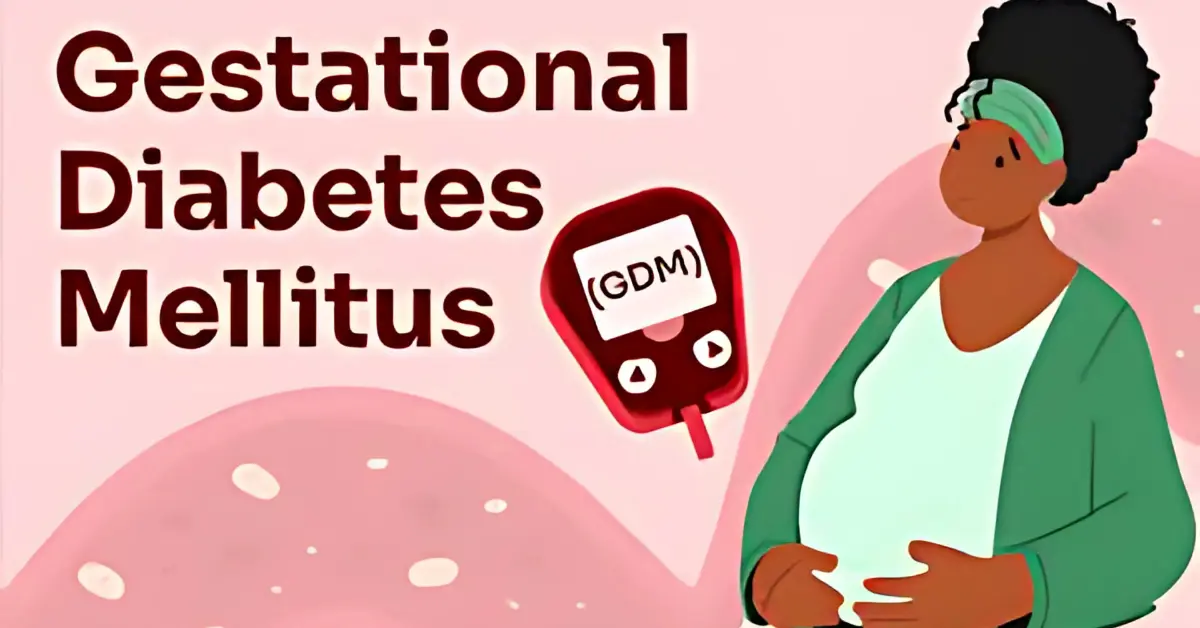Gestational diabetes is a condition that affects many pregnant women, and understanding it is crucial for managing the health of both the mother and the baby. As pregnancy progresses, the body undergoes significant hormonal changes that can affect how it processes sugar (glucose). In this article, we will explore the causes, symptoms, risks, diagnosis, and ways to manage gestational diabetes to ensure a healthy pregnancy.
Table of Contents
ToggleKey Takeaways
- Gestational diabetes (GD) is a form of diabetes that occurs during pregnancy, typically in the second or third trimester. It results from the body’s inability to produce enough insulin, leading to high blood sugar levels.
- Hormonal changes during pregnancy are the primary cause of gestational diabetes, but obesity, age, family history, and ethnicity can also increase the risk.
- Regular screening for gestational diabetes is essential, as many women do not experience symptoms. Blood tests like the Glucose Challenge Test (GCT) and Oral Glucose Tolerance Test (OGTT) are used to diagnose the condition.
- Managing gestational diabetes involves lifestyle changes, such as adopting a healthy, balanced diet, regular physical activity, and monitoring blood sugar levels. In some cases, insulin therapy may be required.
- Postpartum care is crucial, as gestational diabetes increases the risk of developing type 2 diabetes later in life. It is recommended to undergo glucose testing 6-12 weeks after childbirth and maintain a healthy lifestyle to reduce future risks.
- Breastfeeding has many health benefits, including helping regulate the baby’s blood sugar levels and lowering the mother’s risk of developing type 2 diabetes.
- By following the advice of healthcare providers, women with gestational diabetes can have a healthy pregnancy, safe delivery, and long-term health for both themselves and their baby.
What is Gestational Diabetes?
Gestational diabetes is a form of diabetes that develops during pregnancy, typically in the second or third trimester. It occurs when the body cannot produce enough insulin to regulate blood sugar levels effectively. Insulin is a hormone that helps control blood sugar by allowing it to enter the cells for energy. However, pregnancy hormones can interfere with this process, leading to insulin resistance.
In most cases, gestational diabetes resolves after childbirth. However, it can lead to complications for both the mother and the baby, which is why it is essential to diagnose and manage the condition early on.
Causes of Gestational Diabetes
The primary cause of gestational diabetes is insulin resistance. During pregnancy, the placenta produces hormones to help the baby grow, but these same hormones can also make the mother’s cells less responsive to insulin. As a result, the body needs more insulin to keep blood sugar levels stable.
Several factors can increase the likelihood of developing gestational diabetes, including:
- Hormonal Changes: Pregnancy hormones, such as estrogen and progesterone, reduce the body’s ability to process insulin efficiently, leading to insulin resistance.
- Obesity: Being overweight before pregnancy is a significant risk factor because extra body fat can contribute to insulin resistance.
- Age: Women over the age of 25 are at higher risk, and the risk increases as you age.
- Family History: A family history of diabetes, particularly type 2 diabetes, increases the chances of developing gestational diabetes.
- Ethnicity: Women of Hispanic, African American, Native American, and Asian American descent are at greater risk.
Understanding these causes helps identify women at higher risk and highlights the importance of early screening during pregnancy.
Signs and Symptoms of Gestational Diabetes
Gestational diabetes often doesn’t have noticeable symptoms, making it difficult to detect without screening. However, some women may experience:
- Excessive Thirst and Frequent Urination: Increased blood sugar levels can make you feel thirstier and lead to more frequent urination.
- Fatigue: When blood sugar isn’t well-regulated, it can leave you feeling constantly tired or sluggish.
- Blurred Vision: High blood sugar can cause fluid imbalances in the eyes, leading to blurry vision.
- Frequent Infections: Increased blood sugar levels can weaken the immune system, making you more prone to infections, especially urinary tract infections (UTIs).
- Unexplained Weight Loss: Some women may lose weight despite a normal appetite or eating habits.
While these symptoms may seem typical of pregnancy, they could also signal gestational diabetes. That’s why routine screening tests are so important.
How Gestational Diabetes Affects Pregnancy
Gestational diabetes, when not well managed, can cause serious complications for both the mother and the baby. It is crucial to manage the condition to prevent risks such as:
1. Risks for the Mother
- Preeclampsia: Women with gestational diabetes are more likely to develop preeclampsia, a condition marked by high blood pressure that can cause organ damage and other complications. Preeclampsia can lead to premature birth, low birth weight, and even stillbirth.
- Increased Risk of Type 2 Diabetes: Women who had gestational diabetes are at a higher risk of developing type 2 diabetes later in life—up to 50-70% of women with gestational diabetes will develop it within 5-10 years. This risk can be managed through lifestyle changes after pregnancy.
- Cesarean Delivery: Due to the potential for macrosomia (a large baby), it may increase the likelihood of needing a C-section, which comes with its own set of recovery challenges and potential complications.
2. Risks for the Baby
- Macrosomia (Large Baby): High blood sugar can lead to a larger-than-average baby, which can make vaginal delivery more difficult and increase the risk of birth injuries, such as shoulder dystocia (when the baby’s shoulder gets stuck during delivery).
- Neonatal Hypoglycemia: Babies born to mothers with gestational diabetes may experience low blood sugar (hypoglycemia) after delivery, requiring medical attention. Symptoms of hypoglycemia in babies include lethargy, difficulty feeding, and shaking.
- Respiratory Problems: Babies born prematurely or to mothers with poorly managed gestational diabetes are at risk of respiratory distress syndrome, which can cause difficulty breathing. This can require a stay in the neonatal intensive care unit (NICU).
- Long-Term Health Risks: Babies born to mothers with gestational diabetes have a higher risk of developing obesity and type 2 diabetes as they grow older. They may also face metabolic complications that can affect their overall health later in life.
Diagnosing Gestational Diabetes
Gestational diabetes is typically diagnosed through a series of blood tests conducted between 24 and 28 weeks of pregnancy. These tests include:
1. Glucose Challenge Test (GCT)
In this initial screening, you will be asked to drink a sugary solution, and your blood sugar will be tested an hour later. If your blood sugar levels are higher than the normal range, your doctor will recommend additional testing.
2. Oral Glucose Tolerance Test (OGTT)
If the GCT results are abnormal, you’ll undergo an OGTT. In this test, you will fast overnight, drink a sugary solution, and have your blood sugar levels tested multiple times over several hours. A diagnosis of gestational diabetes is confirmed if blood sugar levels remain elevated.
It’s important to remember that these tests are standard, and early detection ensures proper care for both mother and baby.
Managing Gestational Diabetes
With the right care and lifestyle adjustments, gestational diabetes can be managed effectively. Here are key strategies to maintain blood sugar control during pregnancy:
1. Healthy Eating and Balanced Diet
Eating a balanced, nutrient-rich diet is crucial for managing blood sugar levels. Follow these tips for a gestational diabetes-friendly diet:
- Choose Whole Grains: Foods like brown rice, quinoa, oats, and whole-wheat bread provide fiber and help stabilize blood sugar.
- Include Lean Protein: Include protein-rich foods like chicken, fish, eggs, beans, and tofu, which help balance blood sugar.
- Control Portion Sizes: Eating smaller, frequent meals throughout the day helps prevent large blood sugar spikes.
- Avoid Refined Sugars: Limit sugary drinks, sweets, and processed foods to prevent rapid blood sugar increases.
- Fiber-Rich Foods: Increase your intake of vegetables, fruits, and legumes, which help slow the absorption of glucose.
A registered dietitian can help design a meal plan that works for your pregnancy and blood sugar needs.
2. Regular Exercise
Exercise helps improve insulin sensitivity and regulate blood sugar levels. Aim for at least 30 minutes of moderate activity most days of the week, such as walking, swimming, or prenatal yoga. Exercise also boosts your mood and energy levels, helping to combat fatigue, which is common in pregnancy.
Before starting a new exercise regimen, always check with your healthcare provider to ensure the activity is safe for you and your baby.
3. Blood Sugar Monitoring
Monitoring blood sugar levels several times a day is a key part of managing gestational diabetes. Checking your blood sugar before and after meals, as well as before bed, will help you stay within the target range. Keeping a log of your results and sharing them with your healthcare provider can help you and your doctor make necessary adjustments to your care plan.
4. Medication and Insulin Therapy
If lifestyle changes alone don’t control blood sugar levels, insulin may be required. Insulin is the most common medication for gestational diabetes, and some women may also take oral medications like metformin if prescribed by their doctor.
It’s important to follow your doctor’s advice about medication and insulin usage. Medications help manage blood sugar levels effectively, reducing the risk of complications.
Postpartum Care: Managing Long-Term Health
Even after childbirth, it is essential to continue monitoring your health. Although gestational diabetes often resolves after delivery, it does not mean you’re completely in the clear. Here’s what to focus on:
1. Postpartum Testing
It’s crucial to have a glucose test 6 to 12 weeks postpartum to check for type 2 diabetes. This test is essential as gestational diabetes increases your risk of developing type 2 diabetes later in life.
2. Healthy Lifestyle Choices
Maintaining a healthy weight, eating a balanced diet, and staying active are key to preventing type 2 diabetes. Continue to focus on:
- Balanced Meals: Focus on whole foods like fruits, vegetables, and lean proteins.
- Regular Exercise: Keeping physically active reduces the risk of developing type 2 diabetes and helps maintain overall health.
- Weight Loss: If overweight, losing even a small amount of weight (5-10%) can help lower the risk of type 2 diabetes.
3. Benefits of Breastfeeding
Breastfeeding provides many health benefits. It can help regulate the baby’s blood sugar levels and also lower the mother’s risk of developing type 2 diabetes in the future.
Breastfeeding also offers emotional benefits, strengthening the bond between mother and baby while providing essential nutrients to the baby. Additionally, studies show that breastfeeding for longer periods can have a lasting positive impact on both the mother’s and the child’s health.
Mental Health and Emotional Well-being
Managing gestational diabetes can be stressful, and it’s essential to take care of your emotional and mental health. Pregnancy hormones and the changes in your body can sometimes lead to feelings of anxiety or stress. It’s okay to seek support from friends, family, or a counselor if you’re feeling overwhelmed.
Consider joining a support group for women with gestational diabetes. These groups can provide emotional support and offer practical advice from other women who are going through similar experiences. Support networks can also be a valuable resource for tips on managing blood sugar and maintaining a healthy lifestyle post-pregnancy.
Conclusion: Take Charge of Your Health
Gestational diabetes is a serious condition, but with the right management strategies, most women can have a healthy pregnancy and a healthy baby. By following your healthcare provider’s advice, adopting a healthy diet, engaging in regular physical activity, and monitoring your blood sugar levels, you can reduce the risks associated with gestational diabetes.
Remember that even after childbirth, it’s important to continue monitoring your health. Healthy lifestyle choices, including a balanced diet and regular exercise, can help you manage your blood sugar and reduce your risk of developing type 2 diabetes in the future. Being proactive about your health is the key to a long and healthy life.
Frequently Asked Questions (FAQs) about Gestational Diabetes
1. What is the difference between gestational diabetes and type 1 or type 2 diabetes?
Gestational diabetes develops during pregnancy and typically resolves after childbirth. It occurs when the body cannot produce enough insulin to meet the increased demands during pregnancy, leading to high blood sugar levels.
Type 1 diabetes is an autoimmune condition where the body’s immune system attacks the insulin-producing cells in the pancreas, often diagnosed in childhood or early adulthood.
Type 2 diabetes is a chronic condition where the body becomes resistant to insulin or doesn’t produce enough. It is more common in adults and often linked to lifestyle factors such as diet, obesity, and physical inactivity.
While gestational diabetes usually resolves after birth, it increases the risk of developing type 2 diabetes later in life.
2. Can gestational diabetes be prevented?
While you cannot always prevent gestational diabetes, certain lifestyle changes can lower your risk. Maintaining a healthy weight, eating a balanced diet, staying active, and avoiding excessive weight gain during pregnancy are effective strategies for reducing the likelihood of developing gestational diabetes.
If you’re planning a pregnancy and are overweight, losing weight beforehand can also help reduce your risk.
3. How is gestational diabetes diagnosed during pregnancy?
Gestational diabetes is typically diagnosed between 24 and 28 weeks of pregnancy through blood tests. These include:
- Glucose Challenge Test (GCT): You drink a sugary solution, and your blood sugar levels are tested an hour later. If levels are high, further testing is needed.
- Oral Glucose Tolerance Test (OGTT): This test requires fasting overnight, drinking a sugary solution, and checking blood sugar levels at various intervals over several hours.
Your doctor will guide you on when to undergo testing based on your individual risk factors.
4. Can gestational diabetes affect the baby’s health?
Yes, gestational diabetes can affect the baby’s health if not properly managed. Potential risks to the baby include:
- Macrosomia (larger-than-average baby) which can increase the likelihood of a cesarean section.
- Neonatal hypoglycemia, where the baby has low blood sugar after birth, often requires medical intervention.
- Preterm birth, respiratory issues, and jaundice.
- Long-term risks for the child such an increased risk of obesity and type 2 diabetes later in life.
Proper management of blood sugar during pregnancy significantly reduces these risks.
5. Can I still have a normal birth if I have gestational diabetes?
Yes, many women with gestational diabetes have a normal, vaginal delivery. However, having a larger-than-average baby (macrosomia) may increase the chances of complications during delivery, such as shoulder dystocia or the need for a cesarean section. The baby’s size and your overall health will be closely monitored to help determine the safest delivery plan.
6. What should I eat if I have gestational diabetes?
A well-balanced diet is key to managing gestational diabetes. Focus on:
- Complex carbohydrates (whole grains, vegetables, and fruits).
- Lean proteins (chicken, fish, beans).
- Healthy fats (avocados, nuts, and olive oil).
- Fiber-rich foods to help stabilize blood sugar levels.
It’s important to monitor portion sizes and avoid foods with a high glycemic index, such as sugary snacks and refined carbohydrates. Working with a nutritionist can help create a meal plan tailored to your specific needs.
7. Can I exercise with gestational diabetes?
Yes, regular exercise is highly recommended for managing gestational diabetes. Activities like walking, swimming, and prenatal yoga can help lower blood sugar levels and improve insulin sensitivity. Always check with your healthcare provider before starting any exercise regimen to ensure it’s safe for both you and your baby.
8. Do I need to take insulin for gestational diabetes?
Insulin is not always required for gestational diabetes. Many women can control their blood sugar through diet and exercise alone. However, if blood sugar levels remain high despite these lifestyle changes, insulin therapy may be necessary. Insulin is considered safe during pregnancy and is usually injected into the skin. Your doctor will guide you on how to manage your insulin if needed.
9. Can gestational diabetes affect me after childbirth?
After childbirth, most women’s blood sugar levels return to normal. However, having gestational diabetes increases the risk of developing type 2 diabetes later in life. It’s important to follow up with your healthcare provider for glucose testing 6-12 weeks postpartum to check for diabetes.
Maintaining a healthy lifestyle after birth—through regular exercise, a balanced diet, and weight management—can significantly reduce the risk of type 2 diabetes.
10. Is it possible to have gestational diabetes and not know it?
Yes, gestational diabetes may not cause obvious symptoms. That’s why routine screening is essential, especially for women who have risk factors like obesity, a family history of diabetes, or advanced maternal age. Even if you feel fine, a blood sugar test is the only reliable way to diagnose the condition.
11. How often should I check my blood sugar during pregnancy?
If you have gestational diabetes, your doctor will guide you on how often to check your blood sugar. Most women are required to test their blood sugar at least four times a day: before meals and at bedtime. Frequent monitoring helps you stay within your target blood sugar range and ensures that adjustments can be made to your diet, exercise, or medication as needed.
Hi, I’m Effi, a health writer passionate about simplifying wellness and empowering you to make informed health choices. With a focus on evidence-based content, I create practical guides and tips for a healthier lifestyle.






